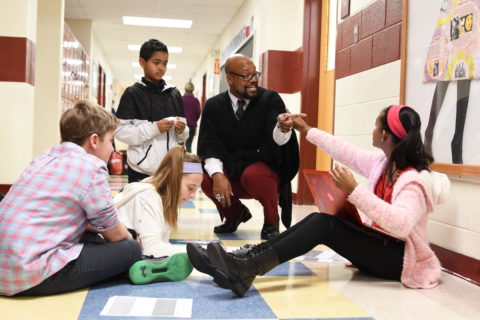This year’s Winter Webinar Series has just wrapped up. My immediate thoughts as the house lights flick out are that this is perhaps the most important topic we have ever taken on – At the Intersection: Creating a Culture of Belonging Through the Lens of Diversity, Equity, & Belonging (DEB) and Mind, Brain, and Education (MBE). Weaving together MBE and DEB in your pedagogy fits so well with the question that drove us when we created The Center for Transformative Teaching and Learning (CTTL) a decade ago:
What will help students learn, grow, and flourish?
Search through the research; find what helps students learn, grow, and flourish; and translate it into actionable strategies that can come alive in real classrooms, schools, and districts. Then spread the word beyond the walls of our own school. That has been our mission for the past ten years.
We didn’t care which silo of academia ideas came from; if they were robustly backed by research, we would consider them. We would lay them alongside our own professional wisdom as educators, the collective professional wisdom of our colleagues at St. Andrew’s, and the insights from our ever-increasing network of friends in other schools. It is this combination of research evidence and the practical wisdom of professional educators that makes a difference.
Promising principles from MBE become promising practices. MBE gets translated into everyday actions that benefit real students in real classrooms. We gauge how what we are trying is working, and make revisions to our practices based on what we learn. It is a pathway for continued professional growth. And at its heart is that core idea we began with: What will help students learn, grow, and flourish?
Even sticking to principles that have a solid backing in research evidence, that list gets very long very quickly. So where should we start? What MBE competencies should all teachers make sure they are working on?
14 MBE competencies for teachers
Here is a list compiled from our ten years of work. It is not everything that teachers should be doing, but we think these items are doable, likely to have an impact, and the impact is likely to be worth the effort.
This is not a checklist where you put a tick to say “I’ve done this.” MBE is never that; it is always a journey of continued discovery, sharing, and growth. Instead, put a number in each box – mentally adding a number will do – as follows:
1 I have not started this yet
2 I have made some progress but am still figuring out how to make it work
3 I regularly do this, and sometimes it works [inherent in this is (i) none of us are perfect all the time; (ii) the “right” frequency of use depends on the strategy and your context; and (iii) I am collecting some evidence, even if it is informal observation, of how it is working and adjusting my practice based on what I discover].
The nuts and bolts of daily pedagogy
- Teach and assess in multiple modalities, chosen based on what works best for the content.
- Use tons of formative assessment—knowing that anything can be used formatively—and adjust your teaching plans and what students practice based on what you find out.
- Use the research insights to improve the feedback you give.
- Build in lots of spaced retrieval practice.
- Help build executing functioning skills with temporary scaffolding.
- Teach students effective strategies to boost their learning, and develop their metacognition so they are increasingly able to use the right strategy at the right time.
- Use the science of reading.
The link between emotion and cognition
- Prioritize getting to know your students and building relationships, particularly at the start of the year.
- Emotional and physical safety and trust are built by deliberate actions you take.
- Use expectancy, value, cost theory to include elements that boost motivation.
- Harness positive emotions, like humor, empathy, and joy, to boost engagement.
- Students of all ages need opportunities to play.
- Take actions to balance the stress levels of students.
- Homework load is a significant source of stress. The quality of homework has a greater impact on learning than the quantity, so use insights from research to design high quality homework.
Weaving together MBE and DEB in your pedagogy
Let’s weave in another strand, one that takes us back to the story of our just-finished Winter Webinar Series.
Throughout the past ten years, our school has also been deeply involved in developing our knowledge of Diversity, Equity, and Belonging principles, and our ability to make these a core part of our daily practice. In hindsight, it seems bizarre that these two worlds of DEB and MBE were kept as siloed as they were for so long. If we think about a child’s day at school – pick any day – factors that academia puts into either DEB or MBE are intertwined constantly throughout their day.
Just take that physical and emotional act of stepping across the threshold into a classroom: Can I bring anything like my full self into this room? What parts of my identity do I have to put aside in order to be in this space? Do I feel like I can be successful here? Do I know what to do to be successful here? Does my teacher have high expectations of me? Are they going to help me meet those expectations? Do I trust my teacher? Do I feel safe here?
To help our children flourish, we need to bust some silos. Teachers and school leaders need a toolkit of competencies, some of which are grounded in DEB, some in MBE, and some which fit comfortably into both. The list of fourteen MBE principles we listed above are part of that toolkit.
But there is foundational work that has to happen, hard work that underpins this. We need to:
- Start with work that gets us to examine our own identity in order to recognize and reduce bias in our pedagogy, curriculum, assessments, practices, and policies–and we must keep revisiting this vital work.
- Begin to get to know our students’ identities, and begin the continuous work of building and maintaining strong, positive relationships.
- Build spaces that prioritize each child’s academic, psychological, and physical safety.
- Build and maintain each child’s trust.
Belonging is a popular concept right now, but this work has to be done first — it lays the foundation upon which we build a culture of belonging.
With this in place, imagine a world where teachers trained in both DEB and MBE draw on research-informed strategies from both areas, mixed in with their own professional wisdom, in order to create something practical for the situation at hand. One of the joys of teaching is also one of the challenges—no day ever pans out exactly as you planned it. There are a hundred or more situations a day where we might need to draw on our DEB and MBE toolkit.
Let’s continue this work together
Our ten-year journey has been spent helping teachers and school leaders develop their MBE strategies, mindsets, and knowledge. More recently we have been talking about it as building competencies. This is where you are now.
But as we said before, none of us are “done”, and we at the CTTL look forward to being alongside you as your MBE journey continues, and we always love to hear your stories and learn from you, too. One way to do this is to come to The Science of Teaching and School Leadership Academy this summer (online again this year, July 18-21), or get a group of colleagues to come and share MBE strategies with others when they get back.
As we said in our recent article in the NAIS magazine:
There are many interwoven pieces in each child’s story, and many things can make learning challenging. Neither DEB nor MBE alone gives us the complete picture or the full set of strategies to help support them to move forward. Dedicated DEB practitioners and professional development are vital for every school and every teacher—we desperately need to invest in and deepen this work. When we do this, and then combine it with the best of what we know about pedagogy, assessment, metacognition, and the like, we end up with something more powerful.
At ten years old, the CTTL’s journey continues with as much fresh energy as ever. We hope you continue to be part of it.
About our author
Dr. Ian Kelleher is a science teacher at St. Andrew’s Episcopal School, and Head of Research for its Center for Transformative Teaching & Learning. His work focuses on helping teachers translate the science of learning into everyday practices in their own classrooms, and measuring the impact. Ian is the co-author of “Neuroteach: Brain Science and the Future of Education,” and co-designer of Neuroteach Global. Ian is the the inaugural Joseph and Kathleen Dreyfuss Faculty Chair for Research, an endowed position at St. Andrew’s Episcopal School for the lead CTTL researcher.




